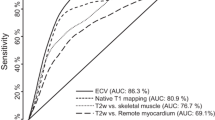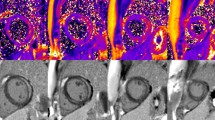Abstract
Introduction
This study evaluated the ability of T1 and T2 mapping cardiovascular magnetic resonance (CMR) to detect myocardial injury in apparently normal myocardium of patients with myocarditis.
Materials and methods
We included 20 patients with “infarct-like” acute myocarditis who had typical focal myocardial lesions on late gadolinium enhancement (LGE) images as well as 20 healthy controls. The CMR protocol consisted of a standard myocarditis protocol which was combined with T1 (modified Look-Locker inversion recovery (MOLLI) with a 3(3)5 scheme and T2 mapping (hybrid gradient- and spin-echo multi-echo sequence, GraSE). First, LGE images were used to depict focal myocardial injury and apparently normal, remote myocardium. Second, native T1, T2 and ECV values were obtained in focal lesions but also in apparently normal myocardium. Third, native T1, T2 and ECV values ≥2 standard deviations above reference values obtained in healthy volunteers were used to quantify myocardial injury in patients with myocarditis.
Results
Apparently normal myocardium had significantly higher median native T1 [1095 (1055–1148) ms] and ECV [34 (32–35) %] values compared to reference values from healthy volunteers, which were 1051 (1021–1064) ms (p < 0.01) and 26 (24–27) % (p < 0.0001). Furthermore, a nonsignificant increase in median myocardial T2 was detected in apparently normal myocardium of patients with myocarditis compared to healthy volunteers [59 (55–65) vs. 56 (54–60) ms; p = 0.18]. Consequently, the amount of myocardial injury was significantly larger on native T1 [48 (32–56) %; p < 0.01] and ECV maps [58 (50–66) %; p < 0.01] compared to LGE [14 (9–20) %].
Conclusions
Native T1 and ECV maps reveal hidden myocardial injury in normal appearing myocardium of patients with myocarditis. The amount of myocardial injury in myocarditis was underestimated by conventional LGE imaging.



Similar content being viewed by others
Abbreviations
- AVS:
-
Acquired voxel size
- CMR:
-
Cardiovascular magnetic resonance
- ECV:
-
Extracellular volume
- HeAT:
-
Heart analysis tool
- IQR:
-
Interquartile range
- LGE:
-
Late gadolinium enhancement
- MOLLI:
-
Modified Look-Locker inversion recovery
- RVS:
-
Reconstructed voxel size
- SFP:
-
Steady-state free precession
- T2w:
-
T2-weighted
References
Caforio AL, Pankuweit S, Arbustini E, Basso C, Gimeno-Blanes J, Felix SB, et al. (2013) Current state of knowledge on aetiology, diagnosis, management, and therapy of myocarditis: a position statement of the European Society of Cardiology Working Group on Myocardial and Pericardial Diseases. Eur Heart J 34(33):2636–2648, 48a–48d
Elezkurtaj S, Lassner D, Schultheiss HP, Escher F (2014) Vascular involvement in cardiac giant cell myocarditis: a new pathophysiological aspect. Clin Res Cardiol 103(2):161–163
Greulich S, Kindermann I, Schumm J, Perne A, Birkmeier S, Grun S et al (2016) Predictors of outcome in patients with parvovirus B19 positive endomyocardial biopsy. Clin Res Cardiol 105(1):37–52
Schultheiss HP, Piper C, Sowade O, Waagstein F, Kapp JF, Wegscheider K, et al. (2016) Betaferon in chronic viral cardiomyopathy (BICC) trial: effects of interferon-beta treatment in patients with chronic viral cardiomyopathy. Clin Res Cardiol. doi:10.1007/s00392-016-0986-9
Weitsman T, Weisz G, Keren A, Hasin T (2016) Prompt benefit of early immunosuppressive therapy in acute lymphocytic myocarditis with persistent heart failure. Clin Res Cardiol. doi:10.1007/s00392-016-0985-x
Zuern CS, Walker B, Sauter M, Schaub M, Chatterjee M, Mueller K et al (2015) Endomyocardial expression of SDF-1 predicts mortality in patients with suspected myocarditis. Clin Res Cardiol 104(12):1033–1043
Illmann A, Riemer T, Erbel R, Giannitsis E, Hamm C, Haude M et al (2014) Disease distribution and outcome in troponin-positive patients with or without revascularization in a chest pain unit: results of the German CPU-Registry. Clin Res Cardiol 103(1):29–40
Poryo M, Khreish F, Schafers HJ, Abdul-Khaliq H (2016) A case of myocardial bridging as a rare cause of chest pain in children. Clin Res Cardiol 105(3):279–281
Ukena C, Kindermann M, Mahfoud F, Geisel J, Lepper PM, Kandolf R et al (2014) Diagnostic and prognostic validity of different biomarkers in patients with suspected myocarditis. Clin Res Cardiol 103(9):743–751
Florian A, Schaufele T, Ludwig A, Rosch S, Wenzelburger I, Yildiz H et al (2015) Diagnostic value of CMR in young patients with clinically suspected acute myocarditis is determined by cardiac enzymes. Clin Res Cardiol 104(2):154–163
Friedrich MG, Sechtem U, Schulz-Menger J, Holmvang G, Alakija P, Cooper LT et al (2009) Cardiovascular magnetic resonance in myocarditis: a JACC white paper. J Am Coll Cardiol 53(17):1475–1487
Baccouche H, Mahrholdt H, Meinhardt G, Merher R, Voehringer M, Hill S et al (2009) Diagnostic synergy of non-invasive cardiovascular magnetic resonance and invasive endomyocardial biopsy in troponin-positive patients without coronary artery disease. Eur Heart J 30(23):2869–2879
Vermes E, Childs H, Carbone I, Barckow P, Friedrich MG (2013) Auto-threshold quantification of late gadolinium enhancement in patients with acute heart disease. J Magn Reson Imaging JMRI 37(2):382–390
Zagrosek A, Abdel-Aty H, Boye P, Wassmuth R, Messroghli D, Utz W et al (2009) Cardiac magnetic resonance monitors reversible and irreversible myocardial injury in myocarditis. JACC Cardiovasc Imaging 2(2):131–138
Friedrich MG, Strohm O, Schulz-Menger J, Marciniak H, Luft FC, Dietz R (1998) Contrast media-enhanced magnetic resonance imaging visualizes myocardial changes in the course of viral myocarditis. Circulation 97(18):1802–1809
Basso C, Calabrese F, Angelini A, Carturan E, Thiene G (2013) Classification and histological, immunohistochemical, and molecular diagnosis of inflammatory myocardial disease. Heart Fail Rev 18(6):673–681
aus dem Siepen F, Buss SJ, Andre F, Seitz S, Giannitsis E, Steen H et al (2015) Extracellular remodeling in patients with wild-type amyloidosis consuming epigallocatechin-3-gallate: preliminary results of T1 mapping by cardiac magnetic resonance imaging in a small single center study. Clin Res Cardiol 104(8):640–647
Ferreira VM, Piechnik SK, Robson MD, Neubauer S, Karamitsos TD (2014) Myocardial tissue characterization by magnetic resonance imaging: novel applications of T1 and T2 mapping. J Thorac Imaging 29(3):147–154
Moon JC, Messroghli DR, Kellman P, Piechnik SK, Robson MD, Ugander M et al (2013) Myocardial T1 mapping and extracellular volume quantification: a Society for Cardiovascular Magnetic Resonance (SCMR) and CMR Working Group of the European Society of Cardiology consensus statement. J Cardiovasc Magn Reson Off J Soc Cardiovasc Magn Reson 15:92
Schumm J, Greulich S, Sechtem U, Mahrholdt H (2014) T1 mapping as new diagnostic technique in a case of acute onset of biopsy-proven viral myocarditis. Clin Res Cardiol 103(5):405–408
Giri S, Chung YC, Merchant A, Mihai G, Rajagopalan S, Raman SV et al (2009) T2 quantification for improved detection of myocardial edema. J Cardiovas Magn Reson Off J Soc Cardiovas Magn Reson 11:56
Thavendiranathan P, Walls M, Giri S, Verhaert D, Rajagopalan S, Moore S et al (2012) Improved detection of myocardial involvement in acute inflammatory cardiomyopathies using T2 mapping. Circ Cardiovas Imaging 5(1):102–110
Ugander M, Bagi PS, Oki AJ, Chen B, Hsu LY, Aletras AH et al (2012) Myocardial edema as detected by pre-contrast T1 and T2 CMR delineates area at risk associated with acute myocardial infarction. JACC Cardiovas Imaging 5(6):596–603
Ferreira VM, Piechnik SK, Dall’Armellina E, Karamitsos TD, Francis JM, Choudhury RP et al (2012) Non-contrast T1-mapping detects acute myocardial edema with high diagnostic accuracy: a comparison to T2-weighted cardiovascular magnetic resonance. J Cardiovas Magn Reson Off J Soc Cardiovas Magn Reson 14:42
Messroghli DR, Niendorf T, Schulz-Menger J, Dietz R, Friedrich MG (2003) T1 mapping in patients with acute myocardial infarction. J Cardiovas Magn Reson Off J Soc Cardiovas Mag Reson 5(2):353–359
Bull S, White SK, Piechnik SK, Flett AS, Ferreira VM, Loudon M et al (2013) Human non-contrast T1 values and correlation with histology in diffuse fibrosis. Heart 99(13):932–937
Iles L, Pfluger H, Phrommintikul A, Cherayath J, Aksit P, Gupta SN et al (2008) Evaluation of diffuse myocardial fibrosis in heart failure with cardiac magnetic resonance contrast-enhanced T1 mapping. J Am Coll Cardiol 52(19):1574–1580
Arheden H, Saeed M, Higgins CB, Gao DW, Bremerich J, Wyttenbach R et al (1999) Measurement of the distribution volume of gadopentetate dimeglumine at echo-planar MR imaging to quantify myocardial infarction: comparison with 99mTc-DTPA autoradiography in rats. Radiology 211(3):698–708
Bohnen S, Radunski UK, Lund GK, Kandolf R, Stehning C, Schnackenburg B, et al. (2015) Performance of t1 and t2 mapping cardiovascular magnetic resonance to detect active myocarditis in patients with recent-onset heart failure. Circ Cardiovas Imaging 8(6). doi:10.1161/CIRCIMAGING.114.003073
Ferreira VM, Piechnik SK, Dall’Armellina E, Karamitsos TD, Francis JM, Ntusi N et al (2013) T(1) mapping for the diagnosis of acute myocarditis using CMR: comparison to T2-weighted and late gadolinium enhanced imaging. JACC Cardiovas Imaging 6(10):1048–1058
Radunski UK, Lund GK, Stehning C, Schnackenburg B, Bohnen S, Adam G et al (2014) CMR in patients with severe myocarditis: diagnostic value of quantitative tissue markers including extracellular volume imaging. JACC Cardiovas Imaging 7(7):667–675
Ferreira VM, Piechnik SK, Dall’Armellina E, Karamitsos TD, Francis JM, Ntusi N et al (2014) Native T1-mapping detects the location, extent and patterns of acute myocarditis without the need for gadolinium contrast agents. J Cardiovas Magn Reson Off J Soc Cardiovas Magn Reson 16:36
Abdel-Aty H, Boye P, Zagrosek A, Wassmuth R, Kumar A, Messroghli D et al (2005) Diagnostic performance of cardiovascular magnetic resonance in patients with suspected acute myocarditis: comparison of different approaches. J Am Coll Cardiol 45(11):1815–1822
Francone M, Chimenti C, Galea N, Scopelliti F, Verardo R, Galea R et al (2014) CMR sensitivity varies with clinical presentation and extent of cell necrosis in biopsy-proven acute myocarditis. JACC Cardiovas Imaging 7(3):254–263
Saring D, Ehrhardt J, Stork A, Bansmann MP, Lund GK, Handels H (2006) Computer-assisted analysis of 4D cardiac MR image sequences after myocardial infarction. Methods Inf Med 45(4):377–383
Kim RJ, Fieno DS, Parrish TB, Harris K, Chen EL, Simonetti O et al (1999) Relationship of MRI delayed contrast enhancement to irreversible injury, infarct age, and contractile function. Circulation 100(19):1992–2002
Lund GK, Stork A, Saeed M, Bansmann MP, Gerken JH, Muller V et al (2004) Acute myocardial infarction: evaluation with first-pass enhancement and delayed enhancement MR imaging compared with 201Tl SPECT imaging. Radiology 232(1):49–57
Mahrholdt H, Wagner A, Holly TA, Elliott MD, Bonow RO, Kim RJ et al (2002) Reproducibility of chronic infarct size measurement by contrast-enhanced magnetic resonance imaging. Circulation 106(18):2322–2327
Roujol S, Weingartner S, Foppa M, Chow K, Kawaji K, Ngo LH et al (2014) Accuracy, precision, and reproducibility of four T1 mapping sequences: a head-to-head comparison of MOLLI, ShMOLLI, SASHA, and SAPPHIRE. Radiology 272(3):683–689
Kellman P, Hansen MS (2014) T1-mapping in the heart: accuracy and precision. J Cardiovas Magn Reson Off J Soc Cardiovas Magn Reson 16:2
Fernandez-Jimenez R, Sanchez-Gonzalez J, Aguero J, Garcia-Prieto J, Lopez-Martin GJ, Garcia-Ruiz JM et al (2015) Myocardial edema after ischemia/reperfusion is not stable and follows a bimodal pattern: imaging and histological tissue characterization. J Am Coll Cardiol 65(4):315–323
Kellman P, Bandettini WP, Mancini C, Hammer-Hansen S, Hansen MS, Arai AE (2015) Characterization of myocardial T1-mapping bias caused by intramyocardial fat in inversion recovery and saturation recovery techniques. J Cardiovas Magn Reson Off J Soc Cardiovas Magn Reson 17:33
Author information
Authors and Affiliations
Corresponding author
Ethics declarations
Conflict of interest
Christian Stehning is an employee of Philips Research Germany and Dr. Schnackenburg is an employee of Philips Healthcare Germany. The other authors do not have relationships relevant to the contents of this paper to disclose.
Rights and permissions
About this article
Cite this article
Radunski, U.K., Lund, G.K., Säring, D. et al. T1 and T2 mapping cardiovascular magnetic resonance imaging techniques reveal unapparent myocardial injury in patients with myocarditis. Clin Res Cardiol 106, 10–17 (2017). https://doi.org/10.1007/s00392-016-1018-5
Received:
Accepted:
Published:
Issue Date:
DOI: https://doi.org/10.1007/s00392-016-1018-5




